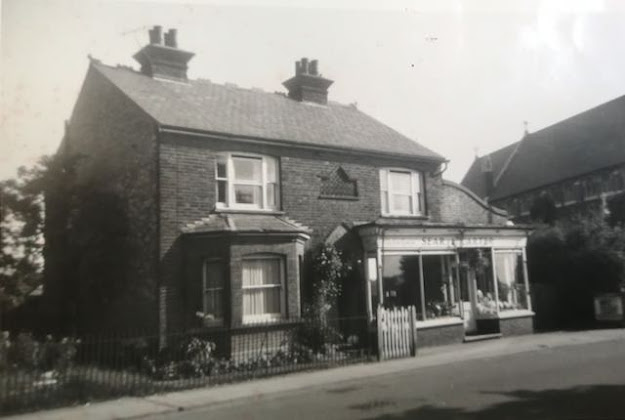 |
| Frank Sear outside his shop, plants in pots above the fascia showing off his trade. The picket fence and gate protecting the private house. The houses in the background are those in Clarence Road. |
To start from the beginning, Frank and Elizabeth Sear moved to St Albans in 1899 and purchased a detached house in Hatfield Road. Because of his trade he did not simply need a house, but land on which he could continue as a nurseryman and florist. The red outline in the map below (from 1924) indicated the extent of the site he acquired and that included the corner area on which St Paul's Church was later built, and the wedge shape between the rear gardens of Clarence and Blandford roads. When the St Peter's Mission Church in Stanhope Road planned its next move it purchased its Blandford Road site from Frank Sear, not the developer Horace Slade.
 |
| The shop is circled; the red lines mark the boundary of the nursery. MAP COURTESY NATIONAL LIBRARY OF SCOTLAND |
Until the new Hatfield Road buildings went up it wasn't easy to state where you were, but there was a commonly used named for a group of fields between Sandpit Lane and Hatfield Road: Ninefields. Frank Sear therefore chose that name for his nursery.
 |
| Post WW1 photo; the fascia now displays Sear & Carter; the wooden picket fence has now been replaced by railings. COURTESY MARK CARTER |
It is not clear whether Sear commissioned the house or whether he purchased the finished building. If the latter, it was the only detached house along the road. In recent posts mention has been made of the narrow front gardens, but so far this is the only example of such a building with its front picket fence separating the garden space from the public footpath.
By 1910 Frank Sear was deeply embedded in his business, and had teamed up with Gere, a Monumental Mason who had a section of the plot to the left of the house. Useful because Sear's was opposite the cemetery, and special floral arrangements could be created for the chapel and for wreaths.
In 1911 or 1912 Thomas and Ada Carter moved from Lincolnshire to St Albans. Thomas was a nursery foreman, and he and Frank Sear created a business partnership and the nursery trade expanded as Sear & Carter. Thomas was instrumental in searching out spare plots of land nearby, including The Dell in Sandpit Lane, which was used as a trial ground.
Because of the nature of his work Thomas managed to avoid volunteering or conscription until early in 1918, and he was not sent to the front until a matter of weeks before the armistice – unfortunately just in time to sustain serious injuries. Thereafter, the people of Fleetville would be used to seeing him around as shown in the photo. Thomas and his family continued to run the shop and nursery with its greenhouses until 1960 when St Albans Council put a claim on the property and compulsorily purchased it for the construction of flats and elderly persons accommodation via a new access road called St Paul's Place.
The business transferred to Smallford and continued under the existing name before being acquired by Notcutts Garden Centres.
So, sixty years have passed without Sear & Carter's shop and the Ninefields Nursery, a real family business. In fact a business of two families.




No comments:
Post a Comment